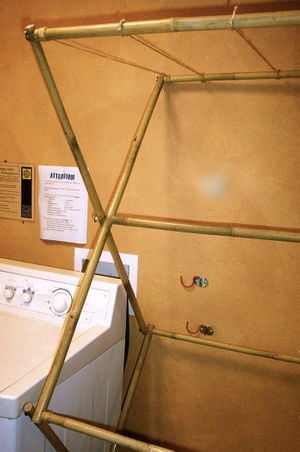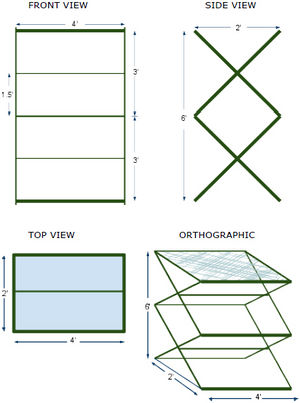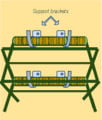

The purpose of this project was to come up with an attractive, sustainable, and space efficient clothes drying system for HSU's CCAT. With the general goal to help educate and inspire others who seek alternative solutions to everyday waste problems. This project was replaced with CCAT DraftMaster
Historically clothes drying has taken place on clothes lines that we could view hanging off peoples balconies throughout the city. This occurred through solar radiation and wind convection causing evaporation. As many energy conservationists may already know, drying clothes in a traditional drier contributes to a large part of the average households energy use.[verification needed]
At HSU's CCAT building, three student co-directors reside and have clothes drying needs every week. Since CCAT's main focus is to "educate the public about the impacts of our technologies on the environment"[1] it would seem fitting to design and build a energy free drying system for their washed clothes. The goal is to build a passive clothes drying system for the CCAT house. Using both a simple yet effective design that could be easily copied by others desiring to ween them selves from yet another energy dependent device. As well as being space efficient and esthetically pleasing so others would want to use one.[2]
Why bother?[edit | edit source]
Conventional driers contribute to a large part of the average persons carbon footprint which has been linked to global warming. This is a easy way to make a big difference plus it's better for your clothes (see Clothes Drying).
CCAT[edit | edit source]
Parameters:
- Fits in a 2'x4' space with a 8' high ceiling
- Holds heavier wet items like blankets and sheets
- Must look 'good' while in use
Use:
- 3 people x load/person = 3 loads a week
- They have spin washer and small, flimsy drying racks
- Will serve as an example piece for others
- Simple to build
- Low tech
Weather:
- often cloudy if not rainy
- can change quickly during the day
- high humidity
What is needed?[edit | edit source]
-
Support brackets
-
Peg in bamboo
Materials[edit | edit source]
| Materials | Use | Quantity | Unit Cost | Total Cost |
|---|---|---|---|---|
| #6 Drywall mounts | screws | 8 | $0.12/ea | $0.96 |
| Screws #6 | joining | 34 | $0.08 ea | $2.72 |
| 1" Washers(small hole) | holding dowells | 16 | $0.12 | $1.92 |
| Bamboo | frame | 64ft | $1.88/8ft | $15.04 |
| Broom hooks | rack support | 4 | $3.99/2 | $7.98 |
| Twine | tension/support | 40' | CCAT | free |
Tools[edit | edit source]
-
Needed tools/materials
-
1/2" drill bit
| Tool | Use | Source | Cost |
|---|---|---|---|
| Table Saw | Cutting Bamboo | CCAT | Free |
| Phillips head screwdriver | Screws | CCAT | Free |
| Drill | Drilling holes and screws | Personal Tools | Free |
| Tape Measure | Measuring | CCAT | |
| Safety glasses | Cutting bamboo | CCAT | Free |
| 1/2" woodboring drill bit | Cutting bamboo | Ace Hardware | $8.99 |
| 3/16" round tip drill bit | pre-drill bamboo | personal tools | free |
| 5/32" round tip drill bit | sheet rock | personal tools | free |
| scissors | cutting twine | CCAT | free |
| Sand paper | smoothing holes & dowells | CCAT | free |
| Wood glue | bamboo/dowell | personal | free |
Cost[edit | edit source]
| Item | Source | Use | Quantity | Unit Cost | Total |
|---|---|---|---|---|---|
| Bamboo | Garden Supply Store | Frame | 64' | $ 1.88/8' | $15.04 |
| Hardware | Ace Hardware | Hinging and joining | 6pc | $> 4.00 | $>24.00 |
| Total | $37.61 | ||||
Design[edit | edit source]
The general design is 2 main rectangles 3.6'x 4' divided into two squares by a horizontal piece. Each rectangle is then joined by a diagonal piece on ether side. Each bottom pole is tied to the leg of it's opossing side peice to prevent over expanding.
The unit should stand about 6' tall 4' wide and 2' deep when extended from the wall and then when not in use collapse against the wall to about 7' tall and about 5" deep or less. The goal is to have more usable space when the device is not needed but still keeping it convenient, sturdy and reliable.
Note: Prices based off of Ace hardware, and Mad River Gardening in Arcata
-
Single side
-
Bamboo poles
Procedure[edit | edit source]
For a rack that measures 6' tall and 2' deep when extended, with 2" diameter bamboo poles.
You'll need to cut:
- The bamboo into poles of 6 x 3'8, 2 x 4', 8 x 3'7"
- The twine into 10 pieces @ 3.5'
Note: Bamboo varies, so measure the diameter of the poles you will join to see how much shorter your short poles should be. ex.) If your poles diameter is 2" minus 4" off the long length to give you 3'8" instead of 4'.
| Bamboo Poles | Use | Quantity | Size |
|---|---|---|---|
| short horizontal | hanging clothes | 6 | 3.7' |
| long horizontal | hanging clothes | 2 | 4' |
| diag. cross piece | support | 8 | 3.6' |
| Wooden Pegs | |||
| joining 2 | cross section | 8 | 4" |
| joining 1 | single bamboo | 8 | 3" |
I recommend gluing the pegs in to the horizontal pieces after seeing that every thing lines up.
Issues[edit | edit source]
-
Side view
Now that it is pretty much done I have a few tips for construction.
- Sheet rock and bamboo gave me a tricky time.
- Both must be drilled first by a small drill. In the Bamboo if you put an initial small hole all the way through you can then take the 1/2" to it one side at a time, not straight through to the other side. If you try it you will splinter the bamboo.
- The sheet rock was trick to use as a anchor. I had intended it as a part of the support for the rack while under a heavy wet load. However I don't think the hooks can hold much more than the empty rack. While installing them the sheet rock crumbled around the first anchor since I did not properly drill out the right size hole before screwing it in. Even the properly done hooks seem like minimal support is offered by there use.
- Pre-drill holes with small bit first to minimize bamboo splitting.
- Test wall for structural integrity to see if support is possible. Rack will stand anchored.
Alternative designs[edit | edit source]
- A pole and line set up. Looks like the frame work for an over sized umbrella.
- A simple line with hooks in living room zigzagging across the ceiling.
- The same design of drying rack but located upstairs near the wood burning stove.
References[edit | edit source]
- ↑ http://web.archive.org/web/20100702004636/http://www.humboldt.edu:80/~ccat/about.php
- ↑ Chhimi Dorji, CCAT Project Manager






